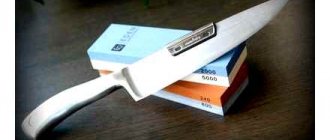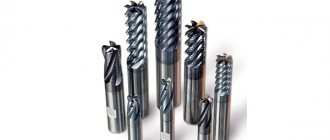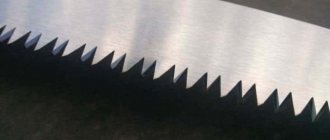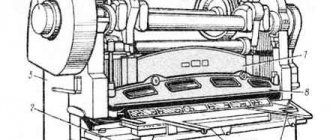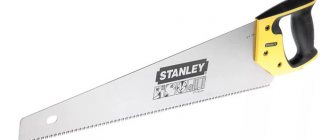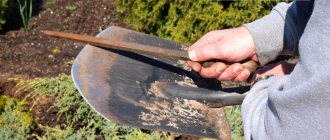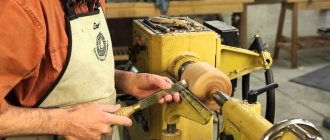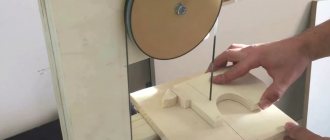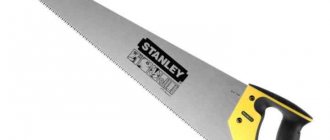Types and design features of hacksaws
Before sharpening a hacksaw, you must know its design. After all, this is a special purpose tool. Its main element is a blade with teeth. They are the ones who cut the tree. The design also includes a handle.
The working metal part in the form of a blade seems to bite into the wood precisely due to the presence of teeth that are located on its lower edge. When the tool makes forward movements, wood material is sawed.
There are many types of wood saws. Although they all have the same purpose. They are used to saw dry and wet wood, such as tree trunks. This tool is often used in construction and finishing work. It is perfect for cutting:
- laminate;
- lag;
- foam plastic (expanded polystyrene);
- plywood;
- bars;
- particleboard;
- boards
A hacksaw is used to cut boards and other lumber. Source tildacdn.com
A hacksaw is even used to carefully cut aerated concrete or foam concrete. However, when working with cellular concrete, the tool teeth quickly become dull. However, they are still subject to intense abrasion. When sawing materials with a hard structure, the service life of this tool is significantly reduced. Therefore, it will be useful for everyone to learn how to sharpen a saw on the job site and not have to go to a hardware store for a new sharp hacksaw.
Important! A lumber saw is not used to cut metal products. For these purposes, saws of the appropriate purpose are used.
The most commonly used hacksaws are the classic ones. They are used by carpenters and joiners. To cut lumber in a miter box, a special saw is used, which is called a reward. If you need to cut a shaped hole, then use a circular saw. This variety is distinguished by the presence of a canvas, the width of which decreases from the handle to the spout.
On a note! There are also two-handed, abutment, hammer, bow and plywood saws.
Types of saws for manual use Source prezentacii.info
Hacksaws for wood also differ in the thickness of the blade. The larger the size of the tool, the more reliable it is and the more convenient it is to saw. Hacksaws have a thin blade that can break if excessive force is applied during operation. However, it is easier to saw raw wood with such a tool. After all, a thin fabric glides better in the material. The thickness of the metal part of the saw is chosen for a specific type of work.
Before sharpening a hacksaw for wood, you need to know whether the tool was subjected to heat treatment during production. After all, its teeth cannot be made sharp if the blade is made of hardened metal. However, the advantage of such saws is their long service life. Although they are usually called disposable tools.
On a note! It is very easy to distinguish between plain and hardened fabric. After all, metal darkens after heat treatment. However, most manufacturers only harden the teeth. However, they also produce models in which the entire fabric is subjected to heat treatment. You must always remember that unhardened metal shines.
Hacksaw blade with hardened teeth Source onlinetrade.ru
See also: Catalog of companies that specialize in remodeling country houses of any complexity
What is the tool for?
There are several types and forms of hacksaws. Moreover, the tool is designed both for working with metal and for working with wood.
For working with metal surfaces, tools are divided into:
- two-handed;
- one-handed.
The former are now used extremely rarely, while the latter are present in almost every home. A one-handed saw has a durable metal blade with a row of teeth. The fabric has high rigidity, it has good elasticity and strength. The tool consists of two parts: a metal blade and a comfortable, most often wooden (or plastic) handle. When working, you need to hold on to such a handle with one hand, and move the saw forward and back along the surface. Moving, the teeth of the blade penetrate deeper into the surface, going deeper at a time by a couple of millimeters.
A wood hacksaw is used for sawing different surfaces:
- boards;
- logs;
- wood of different shapes;
- for cutting branches;
- when performing repair work;
- when working in a carpentry workshop;
- when working with chipboard.
In addition, a piranha-type wood saw can be useful when laying laminate flooring.
There are several types of tools:
- With large teeth.
- With medium teeth.
- With fine teeth.
The size of the teeth is measured based on the number of incisors that are per inch. The more teeth per inch, the better the work will be.
When choosing a hacksaw, you need to take into account that the number of teeth on the file blade has its own marking and is indicated in the form of three letters “TPI”. You also need to know that if you need to get the job done faster or have rough cutting to do, then you can use a hacksaw with a long blade that has a large tooth. But for a high-quality cut, when you need to do the job carefully, you need to use a hacksaw with fine teeth.
A saw, which has large teeth and an intertooth pitch of about four to eight millimeters, is used for sawing thick bars and small logs. And hacksaws with a tooth distance of three to three and a half millimeters will cope with cutting medium-sized boards.
To work with small wood products, you need to use a small hacksaw, which has a cutter spacing of two to two and a half millimeters.
If you are holding a hacksaw with straight teeth, then the tool can be used to cut wood crosswise. If you need to cut a wooden block lengthwise, then it is more advisable to use a hacksaw with teeth that are slightly inclined forward.
In this photo you can see how the teeth on a wood hacksaw are arranged for transverse and longitudinal cutting.
According to the type of teeth and density of the metal blade, files have different names:
- bahco wood hacksaw;
- Irwin wood hacksaw;
- wood hacksaw Bison;
- Stanley wood hacksaw;
- wood hacksaw Gros;
- wood hacksaw Sweden.
Therefore, in your arsenal of tools, you need to have several hacksaws designed for different types of work, both wood and metal.
Features of using a sharp and dull saw
A hand saw for sawing wood, just like any other tool, has certain characteristics. One of these important parameters for a saw is the sharpness of its teeth. If they are dull, then the tree is impossible or difficult to cut.
The need for sharpening arises when the sawyer puts a lot of effort into sawing wood. With a dull saw, the process takes about two or even three times longer. You cannot use a hacksaw whose teeth are very dull for several reasons:
- Significant decrease in performance. After all, a person spends a lot of effort and time.
- Significant reduction in cutting accuracy. A dull hacksaw will not allow you to cut a piece of wood evenly. After all, a blade with blunt teeth will constantly move away from the planned direction of the cut.
- Reduced security level. After all, a saw with non-sharp teeth will get stuck in the wood and if it is pulled out sharply, a person can get hurt.
If you sharply pull out a stuck hacksaw, you can easily get hurt. Source timoelliott.com
A well-sharpened hand saw cuts wood quickly. It instantly bites into the material at the first movement. In this case, the sawyer does not even have to press the tool against the lumber.
The need to sharpen the saw is also indicated by the appearance of a ringing and muffled sound while sawing wood. You will also have to sharpen the tool if the shape of the teeth has changed. After all, they should be in the form of triangles with sharp edges. When the ends of the teeth become rounded, then sawing becomes almost impossible.
Sharp and triangular hacksaw teeth Source onlinetrade.ru
Leveling the height of the links
All teeth must be the same height.
An uneven edge results in uneven loading and significantly reduces work efficiency.
Checking the height of the hacksaw teeth
It is necessary to check the height of the teeth before sharpening the tool.
To do this, place a sheet of plain paper on a hard and flat surface, and press the cutters tightly until a clear imprint is obtained.
If there are teeth protruding from the general row, traces of them will be reflected on the print.
If there are higher teeth, they are carefully cut down with a flat file to the general level.
Hacksaw layout for lumber
The process of sharpening the teeth of a hacksaw is not difficult. However, you need to prepare the tool for it. So, before sharpening a hacksaw on wood, you need to set its sharp ends. The operation is carried out so that the tool moves freely in the material when used. If you do not make the wiring, then the saw will get stuck in the wood. Therefore, the sawing process will be delayed or it will turn into an impossible operation.
A carpenter or joiner knows well how to set the teeth of a hacksaw on wood. The operation itself is the extension of the pointed elements of the cutting edge of the saw. They are bent at the same distance and in different directions. In this case, they are guided by the required cutting width. To increase it, the teeth rake out more. Thanks to the cut, which exceeds the thickness of the blade, it will be better to remove chips from it.
Experts know how to set the teeth on a hacksaw so that the steel blade does not get pinched when cutting lumber. If the pointed elements are bent to a larger angle, then the chance of the saw jamming will decrease.
If the teeth are set insufficiently, the hacksaw will constantly get stuck in the material Source domnomore.com
The wiring for saws is carried out to a certain amount. It depends on the thickness of the metal from which a particular blade is made. Typically, the wiring for the saw is 0.3-2 mm. The choice of a specific value is also influenced by the moisture content of the wood. After all, you have to cut dry and wet lumber:
- If the wood is damp, then the teeth are bent by 0.5-2 mm. The specific value is chosen depending on the thickness of the sheet metal.
- If the wood is dry, the wiring is carried out at a distance of 0.3-0.5 mm.
To ensure that the process is performed as accurately as possible, a special device is used. It represents a template. It has its own design for each hacksaw.
After determining the setting value, specialists usually use a special tool to bend the teeth. Some experienced craftsmen use a simple flat-head screwdriver.
The special tool is pliers. Adjustable plates are also used instead. The design of the special tool includes a stop and a setting that allows you to adjust the amount of wiring manually.
A special tool in the form of pliers for spreading the teeth of a hacksaw Source cs5.livemaster.ru
The process itself begins with securing the canvas. A vice is usually used for this. Then the tool bends the teeth on one side of the hacksaw. Then the process is repeated, but on the other side of the saw.
Important! When bending elements, the bending tool is applied not to the sharp edges, but to the middle of each tooth.
After setting all the teeth, their height is checked. It should be the same for all sharp elements of the hacksaw blade. A sheet of paper is often used to check. It is applied tightly to the teeth. Marks of those sharp elements whose height is greater than others will remain on it. After this, the master shortens the long teeth. To do this, he usually uses a file.
Hacksaw tooth shape
According to GOST 26215, adopted in the USSR back in 1984, hacksaw teeth have a configuration depending on the type of blade:
• for cross cutting – in the form of an isosceles triangle or with one cutting edge; • for longitudinal – according to the type of oblique triangle; • for universal – in the shape of an inclined or right triangle.
Read also: Gas convectors Zhytomyr reviews
Each type has its own secrets and rules on how to sharpen a cutting edge.
Procedure for sharpening with a file
Only after completing the preparatory work, during which the teeth were set and their height was leveled, does the master begin to perform the main operations. Before sharpening a wood saw, it is fixed. A vice is also used for this.
Next, take a small triangular file with a fine notch or a needle file. This tool must fit between the teeth throughout their entire depth.
File and dull saw Source sm-news.ru
Every craftsman who works with wood knows how to sharpen a hacksaw correctly. After all, he performed this operation many times. During its implementation, the master carries out the following actions:
- Checks the reliability of fixing the hacksaw in a vice. The tool should not vibrate. To do this, it is clamped as close to the teeth as possible. However, they must be freely accessible.
- Takes the file with both hands by both ends.
- Determines the sharpening angle by eye. Its value is usually 15-30°. It is easier to identify when the teeth are not very worn.
- Takes a comfortable position so that you can carry out work as comfortably as possible.
- Place the file so that the angle between it and the hacksaw is from 30° to 45°.
- Begins to sharpen the teeth with uniform, quick and clear movements. Moreover, they are performed exclusively in one direction. Usually movements are carried out from bottom to top. First, they are performed exclusively on one side of the hacksaw.
Important! A file is drawn along each face of the tooth 3 to 5 times. The number of passes is selected individually in each specific case. Their number depends on the initial sharpness of the saw.
- Performs sharpening on the other side of the hacksaw.
The teeth are sharpened with a file, first on one side and then on the other side of the saw. Source centrzatochki.ru
In order to sharpen a saw on wood with high quality, the pressure with which the process is carried out is always taken into account. Usually a little force is applied, but with each movement the file is required to remove metal. It is not allowed for him to simply fidget with the teeth.
Now everyone understands how to sharpen a hacksaw on wood with a file. To do the job well, you need to allocate enough time and be patient. At the same time, the process itself is not difficult.
After passing the file over all the teeth on each side of the saw, check their sharpness. To do this, look at the cutting edge of the tool through the sun's rays. If shine appears between the teeth, then the process is completed efficiently. This is usually checked by sawing some piece of wood.
How does a hacksaw work?
Before we begin the story about blade sharpening, let’s look at what types of hacksaws there are and what are the fundamental differences between their different types. Manufacturers offer tools with different types of teeth:
The type of teeth is determined by the number of elements that fall per inch of blade length. This value is designated as TPI and is an international designation that is understandable to any user. Hacksaws with large teeth are considered to be tools in which the number of cutting elements is from 3 to 6 per inch. The intertooth distance in such blades is 4-8 mm, which allows this type of saw to be used for working with large beams, thick boards and even logs. A tooth pitch of 3-3.5 mm indicates that the tool is designed to work with medium-sized boards, and if this value is 2-2.5 mm, then the purpose of such a hacksaw is to work with small parts and thin material.
The teeth also vary in angle. Straight ones are designed for cross-cutting wood, and inclined ones are for working in the longitudinal direction. That is why in a professional carpenter’s tool kit you will always see several hacksaws for different types of work.
Features of sharpening using an angle grinder
Experts also use a grinder to sharpen hacksaws. The use of power tools simplifies the process. It is used for sharpening hand saws and chainsaws. An experienced master performs the process as follows:
- Before sharpening the saw, the specialist selects a blade for the grinder.
For this process, a thin circle is used. Therefore, conventional sharpening discs are not suitable. The master selects a circle based on the distance between the saw teeth. Usually its thickness does not exceed 1.5 mm. The disk with this parameter is 0.8 mm is most often used.
- The master clamps the hacksaw using clamps.
Vices are used extremely rarely, because in them the blade can only be positioned vertically. This position is ideal when the process is carried out with a file. It is inconvenient to sharpen a vertically positioned blade with a grinder.
The hacksaw blade is usually clamped with clamps in a horizontal plane when sharpening with a grinder is performed Source i3.guns.ru
Wooden pads are used together with the vice. They usually look like bars. Wooden linings allow you to more securely fix the hacksaw. To secure the saw, two clamps are used to prevent any movement and vibration of the blade being sharpened.
- The specialist sharpens each saw tooth.
The power tool performs movements between these elements along their edges, having previously selected the desired angle of position of the angle grinder disk.
- The master sharpens the teeth first on one side of the saw, and then repeats the procedure on the other side of the hacksaw.
How to sharpen a hacksaw?
To sharpen with minimal loss of time and quality, you need to use such special devices and tools as:
- Workbench;
- bench vice;
- pliers;
- whetstone;
- sandpaper;
- protractor and caliper;
- hammer;
- It is possible to use equipment that allows you to secure the hacksaw blade at an angle of 90 or 45 degrees.
Be sure to use the following files:
- with a triangular section;
- with a rhombic section;
- flat;
- set of files.
When sharpening a hacksaw for wood, a simple vice is used, which is quite uncomfortable and takes a long time, as well as a multi-axis type vice, since their frame is rotated and fixed at the required angles to ensure the movement of the tool strictly in the horizontal plane. It is recommended to organize additional lighting for the workspace using electric lamps. Throughout the entire sharpening time, the file/needle file must move without jerking, constant pressure must be ensured, movements must be made without deviations from a constant angle. The sharpening process is carried out only by moving the file away from you. The file/needle file must be returned by air, and there should be no contact with the hacksaw.
Read also: Good inexpensive alarm system with auto start
Hacksaws are used for various purposes. Wood is sawn along or across the grain. Accordingly, the teeth will also be different.
Sharpening crosscut saw teeth
When sharpening such teeth, a finely cut triangular file is used. The direction of movement of the tool is an angle of 60 degrees. The hacksaw is secured in the fixture at an angle of 45–50 degrees to the workbench. The file/needle file should be moved strictly horizontally (maintaining an angle of 60–75 degrees to the hacksaw), starting sharpening from the first left tooth. You need to start with “adjusting the movement of the hand with the tool,” for which they are held along each left edge of the odd row of distant teeth, which will give the hand movements the necessary automaticity. After this, the same thing is repeated, sharpening the right edges of the odd teeth to complete the sharpening of the cutting edge and sharpening the points. Having finished sharpening the teeth of the odd row, the hacksaw is turned over in the fastening device and the same steps are repeated for the even row, which in this position is the far row.
Hacksaw for longitudinal cutting
The teeth of rip saws have an angle of less than 60 degrees, so they use needle files with large notches or a finely notched file with a rhombic cross-section. In this case, triangular files are strictly not recommended. For sharpening, the hacksaw is fixed vertically in the device. There are two methods for sharpening a hacksaw, which differ in giving different sharpening angles.
- Straight. The needle file/file is placed at an angle of 90 degrees. It is given a direction parallel to the hacksaw, and both the rear and front cutting surfaces of each tooth are sharpened. This is repeated for the entire distant row of teeth. Then the hacksaw is turned over in the clamping device 180 degrees and the same operation is repeated for the other teeth that will make up the far row.
- Oblique. This method differs from the straight one only in the angle of the direction of movement of the tool to the plane of the blade - the sharpening angle decreases from straight to 80 degrees. The process is exactly the same, but the teeth after sharpening resemble the teeth of a bow saw.
Mixed hacksaw
If it is necessary to restore the sharpness of the teeth, use large-sized notched files or finely cut diamond-shaped files. For mixed-type hacksaws, there are the same two options as for longitudinal and transverse hacksaws. They are distinguished by slightly different sharpening angles (90 and 74–81 degrees, respectively).
Video description
The process of sharpening a hacksaw with a grinder is shown in the video:
The operation of restoring a hand saw using an angle grinder is a more painstaking job than sharpening a chainsaw. However, the process is still not too difficult, but only an experienced master can carry it out efficiently.
Using a grinder allows you to reduce sharpening time by almost half compared to using a file. After all, with a hand tool you need to perform synchronous movements and constantly control the amount of material removed from each tooth.
On a note! After using an angle grinder, the master often sharpens the cutting part of the saw using a file.
The nuances of sharpening a hand saw
When sharpening a hand saw for wood, each master follows a number of rules:
- The hacksaw is most securely attached to a workbench or other fixed base when using a vice or clamps. This will allow you to sharpen the saw efficiently and reduce the likelihood of injury.
- The work area is well illuminated so that even very small teeth can be clearly seen.
- Movements with a sharpening tool are performed exclusively in one direction if the process is carried out with a file.
In addition, to quickly check the quality of sharpening, use sunlight. When hit by rays, the teeth begin to shine if the sharpening process is carried out correctly.
Important! A grinder is not used to sharpen hardened saw teeth, because the metal may break off.
How to properly sharpen a hacksaw with a file
Using a file is still relevant today, so let’s try to figure out how to properly sharpen a hacksaw at home.
Let's start by installing the canvas.
It must be secured, as already mentioned above, in a clamp or vice.
The jaws of the vice must be made of wood, with the width of the “jaws” not less than 200 mm.
The movement of the file should be uniform, and pressure on the teeth should only be applied when moving “forward”.
It is necessary to move the hand with the tool to the starting point freely, without force on the incisors.
In one working pass, a uniform layer of metal is removed, this will preserve the pitch, height and profile of the edge.
The sharpness of the cutter can be reduced due to the formation of burrs on the surface and irregularities after passing the abrasive.
A file cannot sharpen a hacksaw perfectly, but you can get high quality - after sharpening, the smallest file or needle file and whetstone will come in handy.
Burrs are removed by selective grinding with a fine abrasive, and the edges are leveled with a wet whetstone along the side base of the blade.
When you set out to sharpen a hacksaw correctly, pay attention to maintaining the tops of the teeth.
The same height of the cutters and correct setting affect the wear resistance of the tool and the quality of the cut.
Briefly about the main thing
To sharpen a saw intended for sawing wood, it is first clamped in a vice. Then the teeth are set. Then they are leveled in height. Next, take a triangular file and sharpen the prepared teeth with it, first on one and then on the other side of the hacksaw.
When using a grinder, the saw is secured with clamps on a stationary surface. The plane of its canvas should be horizontal relative to the ground. In this case, a disk with a minimum thickness is installed on the grinder. They sharpen saw teeth at an angle of 15-30°.
To cut wood, a classic saw is often used. There are also reward, round, plywood, trigger, two-handled, and axed hacksaws for wood. Each of them consists of a canvas and at least one handle.
Ratings 0
Hacksaw teeth set
The movement of the blade must be free, for which the saw teeth are set apart by the same amount.
To reduce the coefficient of friction and the clamping of the hacksaw in the cut, its width must be greater than the thickness of the working blade, otherwise the metal heats up and expands, which leads to the saw jamming.
The teeth of the hacksaw are set by bending the cutters to the sides.
Using pliers does not allow you to obtain the same angle of inclination - with such a tool you can only cut firewood.
To spread the cutters evenly and get an even, neat cut, use a homemade device for setting the teeth.
To make it, you need a metal die of arbitrary shape with a thickness of 2-3 mm.
Read also: Vacuum forming machine business
In a simple version, several slits are made to indicate the thickness of the canvas.
The tooth is grabbed into the hole and bent until the selected stop is reached.
In the second version, a cut is cut into the plank with a metal file, and two holes are drilled to install the limiter.
Rotating the sector to the sides allows you to adjust the bend angle.
The figure shows a simple model and wiring with a stop.
The design of the device is intuitively easy to manufacture and use.
It is necessary to take into account that the width of the bend has its own parameters.
